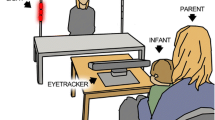Abstract
Children with autism have atypical gaze behavior but it is unknown whether gaze differs during distinct types of reciprocal interactions. Typically developing children (N = 20) and children with autism (N = 20) (4–13 years) made similar amounts of eye contact with an examiner during a conversation. Surprisingly, there was minimal eye contact during interactive play in both groups. Gaze behavior was stable across 8 weeks in children with autism (N = 15). Lastly, gaze behavior during conversation but not play was associated with autism social affect severity scores (ADOS CSS SA) and the Social Responsiveness Scale (SRS-2). Together findings suggests that eye contact in typical and atypical development is influenced by subtle changes in context, which has implications for optimizing assessments of social communication skills.



Similar content being viewed by others
References
American Psychiatric Association, (2012). DSM–5.
Charman, T., Swettenham, J., Baron-Cohen, S., Cox, A., Baird, G., & Drew, A. (1997). Infants with autism: An investigation of empathy, pretend play, joint attention, and imitation. Developmental Psychology, 33(5), 781–789.
Constantino, J. N. (2012). Social Responsiveness Scale Second Edition (SRS-2). Los Angeles: Western Psychological Services.
Dawson, G., Hill, D., Spencer, A., Galpert, L., & Watson, L. (1990). Affective exchanges between young autistic children and their mothers. Journal of Abnormal Child Psychology, 18(3), 335–345.
Dawson, G., Toth, K., Abbott, R., Osterling, J., Munson, J., Estes, A., & Liaw, J. (2004). Early social attention impairments in autism: Social orienting, joint attention, and attention to distress. Developmental Psychology, 40(2), 271–283. doi:10.1037/0012-1649.40.2.271.
Elliott, C. D. (2007). Differential Ability Scales Second Edition. San Antonio, TX: Harcourt Assessment, Inc.
Grzadzinski, R., Carr, T., Colombi, C., McGuire, K., Dufek, S., Pickles, A., & Lord, C. (2016). Measuring changes in social communication behaviors: Preliminary development of the brief observation of social communication change (BOSCC). Journal of Autism and Developmental Disorders. doi:10.1007/s10803-016-2782-9.
Hus, V., Gotham, K., & Lord, C. (2014). Standardizing ADOS domain scores: Separating severity of social affect and restricted and repetitive behaviors. Journal of Autism and Developmental Disorders, 44(10), 2400–2412. doi:10.1007/s10803-012-1719-1.
Kasari, C., Sigman, M., & Yirmiya, N. (1993). Focused and social attention of autistic-children in interactions with familiar and unfamiliar adults: A comparison of autistic, mentally-retarded, and normal-children. Development and Psychopathology, 5(3), 403–414. doi:10.1017/S0954579400004491.
Koegel, R. L., Dyer, K., & Bell, L. K. (1987). The influence of child-preferred activities on autistic children’s social behavior. Journal of Applied Behavior Analysis, 20(3), 243–252. doi:10.1901/jaba.1987.20-243.
Levine, M., & Sutton, B. (1973). Effects of age, sex, and task on visual behavior during dyadic interaction. Developmental Psychology, 9(3), 400–405. doi:10.1037/h0034929.
Lord, C., Rutter, M., DiLavore, P. C., Risi, S., Gotham, K., & Bishop, S. L. (2012). Autism diagnostic observation schedule, Second Edition (ADOS-2) manual (Part 1): Modules 1–4. Torrence, CA: Western Psychological Services.
Mundy, P., Delgado, C. E. F., Block, J., Venezia, M., Hogan, A., & Siebert, J. (2003). A manual for the abridged early social communication scales (ESCS). Unpublished. Retrieved online from http://education.ucdavis.edu/sites/main/files/file-attachments/escs_manual_2003_2013.pdf.
Mundy, P., Sigman, M., Ungerer, J., & Sherman, T. (1986). Defining the social deficits of autism: The contribution of non-verbal communication measures. Journal of Child Psychology and Psychiatry, and Allied Disciplines, 27(5), 657–669.
Nadig, A., Lee, I., Singh, L., Bosshart, K., & Ozonoff, S. (2010). How does the topic of conversation affect verbal exchange and eye gaze? A comparison between typical development and high-functioning autism. Neuropsychologia, 48(9), 2730–2739. doi:10.1016/j.neuropsychologia.2010.05.020.
Rutter, M., LeCouteur, A., & Lord, C. (2003). Autism Diagnostic Interview-Revised (ADI-R) manual. Los Angeles: Western Psychological Services.
Senju, A., & Johnson, M. H. (2009). Atypical eye contact in autism: Models, mechanisms and development. Neuroscience and Biobehavioral Reviews, 33(8), 1204–1214. doi:10.1016/j.neubiorev.2009.06.001.
Stone, W. L., Ousley, O. Y., Yoder, P. J., Hogan, K. L., & Hepburn, S. L. (1997). Nonverbal communication in 2- and 3-year-old children with autism. Journal of Autism and Developmental Disorders, 27(6), 677–696.
Wechsler, D. (2008). Wechsler Adult Intelligence Scale-Fourth Edition. San Antonio, TX: Pearson.
Wechsler, D. (2012). Wechsler preschool and primary scale of intelligence-fourth edition technical and interpretive manual. San Antonio, TX: Pearson.
Wetherby, A., & Prizant, B. (2002). Communication and symbolic behavior scales development profile. Baltimore, MD: Paul H. Brookes.
Ye, Z., Li, Y., Liu, Y., Bridges, C., Rozga, A., & Rehg, J. (2015). Detecting bids for eye contact using a wearable camera. Proceedings of the 11th IEEE International Conference on Automatic Face and Gesture Recognition.
Acknowledgments
This study was funded in part by the Simons Foundation (336363 & 383667), Autism Speaks Meixner Fellowship (7608), the Department of Defense (AR130106), a generous gift from the Mortimer D. Sackler family, the Leon Levy Foundation and the DeWitt-Wallace Reader’s Digest Fund. We thank Richard Vuduc for his assistance with formatting figures.
Author Contributions
RMJ, AH, CC, EK, JMR, CL and AR participated in the design of the study. RMJ, AH and CC collected the data. RMJ, AS, AH, CC, CB, SN, ES, EK, CW and AR participated in the data coding and analysis. RMJ, CW and AR performed the statistical analyses with the oversight of JMR and CL. RMJ and AR drafted the manuscript. All authors read and approved the final manuscript.
Author information
Authors and Affiliations
Corresponding author
Ethics declarations
Conflict of interest
Catherine Lord receives royalties from two measures that were used in this study (ADI-R, ADOS-2) and all proceeds related to this project were donated to charity. No other authors report conflicts of interest.
Ethical Approval
All procedures performed in studies involving human participants were in accordance with the ethical standards of the institutional and/or national research committee and with the 1964 Helsinki declaration and its later amendments or comparable ethical standards.
Electronic supplementary material
Below is the link to the electronic supplementary material.
Rights and permissions
About this article
Cite this article
Jones, R.M., Southerland, A., Hamo, A. et al. Increased Eye Contact During Conversation Compared to Play in Children With Autism. J Autism Dev Disord 47, 607–614 (2017). https://doi.org/10.1007/s10803-016-2981-4
Published:
Issue Date:
DOI: https://doi.org/10.1007/s10803-016-2981-4




